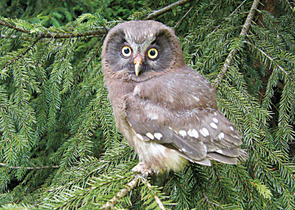The Journal is published by the Nature Conservation Agency of the Czech Republic in cooperation with the Cave Administration of the Czech Republic, the Krkonoše Mts. National Park Administration, the Bohemian Forest Mts. National Park Administration, the Podyjí National Park Administration and the The Bohemian Switzerland National Park Administration. It has been published since 1946.
cs / en
Nature Conservation 5/2010 — 27. 10. 2010 — Research, Surveys and Data Management — Print article in pdf
Increase in Numbers, Habitat Selection and Feeding Ecology of Hole-nesting Avian Predators in North
dutinových ptačích predátorů v horských oblastech severních a východních Čech

Provision of nest-boxes is a technique commonly used to increase nest-site availability and quality for secondary cavity-nesting birds, including hole-nesting raptors and owls.
In 1990–1991, nest-boxes for the Eurasian Kestrel (Falco tinnunculus), Tawny Owl (Strix aluco) and the Tengmalms Owl (Aegolius funereus) were installed in the Jizera Mts., Krkonoše/Giant Mts. and the Orlické hory/Eagle Mts. were installed not only on mountain ridges, but also on their foothills. After erecting new ones including those for the Eurasian Pygmy-owl (Glaucidium passerinum), there have been 1,908 nest-boxes within the area covering 1,400 km2. At present, populations of the Eurasian Kestrel, Tawny Owl and the Tengelmalms Owl can be considered as viable, particularly in the Jizera Mts. and Krkonoše/Giant Mts. where the avian predators have been provided with nest-boxes continuously. After seven years from the launching the project, when the populations studied reached their carrying capacity, the avian predators studied displayed six times higher population density than at the beginning. Because mountain clear-cuts caused by air pollution and originally covered by grassland plant communities have been overgrown by trees and the consequent Field Vole (Microtus agrestis) decline has been continuing, since 2 000 kestrels have changed their hunting behaviour and clearly prefer easily available prey at lower elevations. Above 800 m a.s.l., Tengmalms owls has adapted to forage for food in closed forest stands as well as on grasslands with dispersed solitary trees, using the latter as perching sites. Tawny owls inhabit home ranges in which small mammal community density reaches at least 40–50 individuals per hectare needed for the birds successful reproduction. Under fluctuating small mammal numbers both in mountain forests and on secondary grasslands, Tengmalms owls can rear their young at minimum small mammal community density of 20 individuals/ha: the fact is caused by relatively low daily prey consumption (approx. 1–2 individuals of microtine rodents). Therefore, hunting ranges do not overlap in both the owl species. In rodent poor years, the myophagous birds shift their diet from the main prey to the alternative food (insects, lizards, passerines or shrews).

